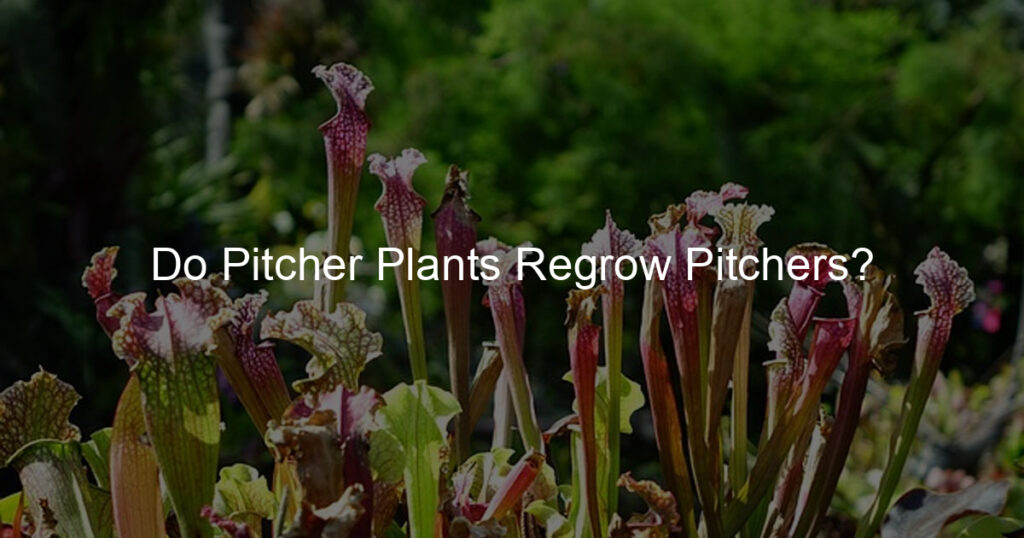Is there anything as beautiful as a pitcher plant in full bloom? These marvelous plants are native to many parts of the world and come in a variety of colors and sizes. They’re also quite fascinating, so it’s no wonder that many people are drawn to them. One question that often comes up about pitcher plants is whether they regrow their pitchers. Let’s take a look at what we know about this process.
Will a pitcher plant grow new pitchers?
Pitcher plants are fascinating creatures — they’re carnivorous and can survive in wet finicky places, as long as they have enough sunlight. Not only that, but these plants reproduce pretty quickly, too. And one of the most interesting things about them is that yes, a pitcher plant can grow new pitchers over time!
These carnivorous plants drink a mix of rainwater and collected animal matter within their leaves or ‘pitchers’, which create an acidic environment where many insects like to hang out. With the right amount of sunlight and water, the pitchers regenerate again and again over time. That’s why they continue to thrive in their boggy habitats – these pitcher plants just don’t quit!
How long does it take for a pitcher plant to grow new pitchers?
Growing pitcher plants is a surprisingly easy and rewarding experience, but one of the most common questions asked by first-time plant parents is: How long does it take for a pitcher plant to grow new pitchers? The answer depends on the species of pitcher plant, their age, and their environment.
Generally speaking, younger plants tend to produce fewer and smaller pitchers than mature ones. Given the right conditions—lots of sunlight, optimal soil nutrition, and enough humidity—it should take a young plant a few weeks to put out lush new pitchers. With regular maintenance and good care, older plants can put out many more impressive pitchers throughout the season!
Should I remove dead pitchers from my pitcher plant?
Removing dead pitchers from your pitcher plant can be beneficial in allowing the remaining pitchers to stay healthy and thrive. If you choose to remove them, it is best to do so very carefully by using sharp scissors or pruners. The removal of these dead parts will prevent diseases from spreading throughout the pitcher plant and help ensure your plant stays beautiful and lush.
In some cases, removing the complete stem the pitcher is attached to may also be necessary. Regularly tending to your pitcher plant will ensure its continued health, so be sure to look for signs of any old or dying parts that need to be removed.
How long do the pitchers last on a pitcher plant?
Depending on the type of pitcher plant, a full pitcher can last for days or weeks. It all depends on the humidity and temperature conditions, as well as how much insect activity is present in the vicinity. For longer-lasting pitchers, look out for Nepenthes alata and Nepenthes maxima; these two species are known to keep their pitchers full and operational considerably longer than other types.
Given sufficient growing conditions, they’re also fast growers and big producers of sweet-smelling nectar that attracts insects like bees, wasps, ants, and flies. But if you don’t have any of these particular species of plants, you might want to check out the infamous Sarracenia leucophylla – it can last a good chunk of time without maintenance or upkeep.
What happens if you cut a pitcher plant?
Cutting a pitcher plant can be unsettling; after all, it’s a living organism! But if you’re brave enough to do the deed, there is no need to worry – pitcher plants are surprisingly resilient and can survive being cut very well.
Cutting a plant into smaller sections can help stimulate new growth. If done properly, it might even result in more pitchers than before! That being said, it is always recommended to leave this sort of job to experts so that your plant remains healthy and unharmed.
Do you feed every pitcher in the pitcher plant?
No, it’s not necessary to feed every pitcher plant. Generally, fertilizing the soil regularly and keeping them in a bright spot is enough to keep them happy. If you do decide to feed your pitchers, you should use an appropriate insect-based fertilizer like dried blood worms, which can be bought from pet stores.
Depending on how big or mature your pitcher is also determined how much you should feed it; generally, 1/4 teaspoon for every ten inches of plant growth should suffice. Just be sure not to overfeed them as too many nutrients can cause pitcher destruction!
Conclusion
So, do pitcher plants regrow pitchers? Yes, they certainly do! Pitcher plants are amazing creatures that have adapted to their environment to survive. If you find yourself with a pitcher plant that has lost its pitchers, don’t worry – they will grow back given time and the right conditions.








